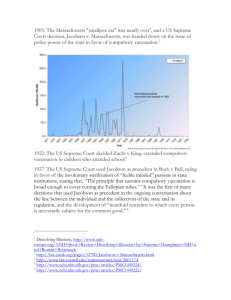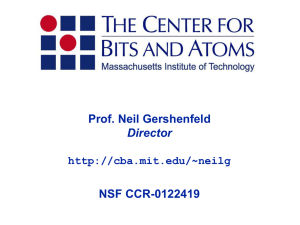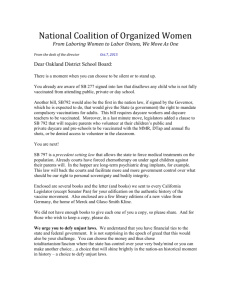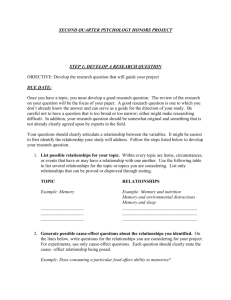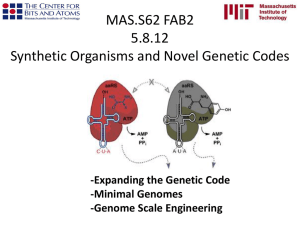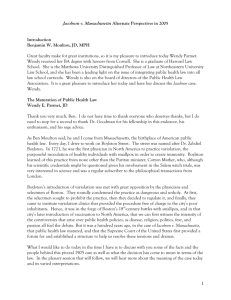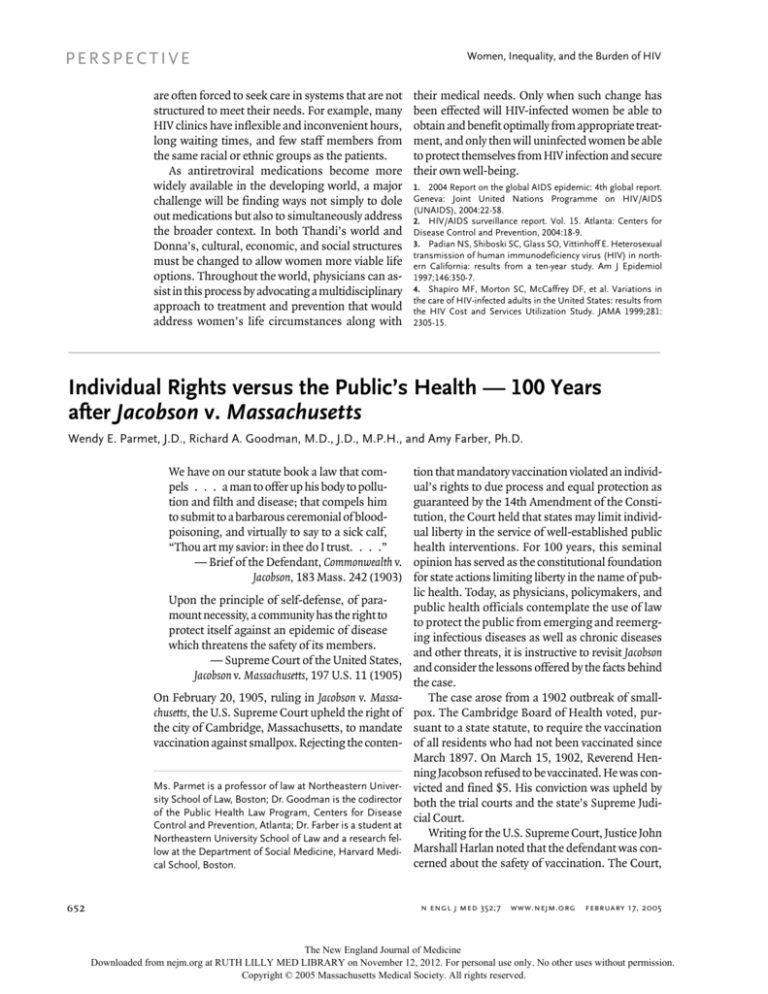
PERSPECTIVE
are often forced to seek care in systems that are not
structured to meet their needs. For example, many
HIV clinics have inflexible and inconvenient hours,
long waiting times, and few staff members from
the same racial or ethnic groups as the patients.
As antiretroviral medications become more
widely available in the developing world, a major
challenge will be finding ways not simply to dole
out medications but also to simultaneously address
the broader context. In both Thandi’s world and
Donna’s, cultural, economic, and social structures
must be changed to allow women more viable life
options. Throughout the world, physicians can assist in this process by advocating a multidisciplinary
approach to treatment and prevention that would
address women’s life circumstances along with
Women, Inequality, and the Burden of HIV
their medical needs. Only when such change has
been effected will HIV-infected women be able to
obtain and benefit optimally from appropriate treatment, and only then will uninfected women be able
to protect themselves from HIV infection and secure
their own well-being.
1. 2004 Report on the global AIDS epidemic: 4th global report.
Geneva: Joint United Nations Programme on HIV/AIDS
(UNAIDS), 2004:22-58.
2. HIV/AIDS surveillance report. Vol. 15. Atlanta: Centers for
Disease Control and Prevention, 2004:18-9.
3. Padian NS, Shiboski SC, Glass SO, Vittinhoff E. Heterosexual
transmission of human immunodeficiency virus (HIV) in northern California: results from a ten-year study. Am J Epidemiol
1997;146:350-7.
4. Shapiro MF, Morton SC, McCaffrey DF, et al. Variations in
the care of HIV-infected adults in the United States: results from
the HIV Cost and Services Utilization Study. JAMA 1999;281:
2305-15.
Individual Rights versus the Public’s Health — 100 Years
after Jacobson v. Massachusetts
Wendy E. Parmet, J.D., Richard A. Goodman, M.D., J.D., M.P.H., and Amy Farber, Ph.D.
We have on our statute book a law that compels . . . a man to offer up his body to pollution and filth and disease; that compels him
to submit to a barbarous ceremonial of bloodpoisoning, and virtually to say to a sick calf,
“Thou art my savior: in thee do I trust. . . .”
— Brief of the Defendant, Commonwealth v.
Jacobson, 183 Mass. 242 (1903)
Upon the principle of self-defense, of paramount necessity, a community has the right to
protect itself against an epidemic of disease
which threatens the safety of its members.
— Supreme Court of the United States,
Jacobson v. Massachusetts, 197 U.S. 11 (1905)
On February 20, 1905, ruling in Jacobson v. Massachusetts, the U.S. Supreme Court upheld the right of
the city of Cambridge, Massachusetts, to mandate
vaccination against smallpox. Rejecting the conten-
Ms. Parmet is a professor of law at Northeastern University School of Law, Boston; Dr. Goodman is the codirector
of the Public Health Law Program, Centers for Disease
Control and Prevention, Atlanta; Dr. Farber is a student at
Northeastern University School of Law and a research fellow at the Department of Social Medicine, Harvard Medical School, Boston.
652
tion that mandatory vaccination violated an individual’s rights to due process and equal protection as
guaranteed by the 14th Amendment of the Constitution, the Court held that states may limit individual liberty in the service of well-established public
health interventions. For 100 years, this seminal
opinion has served as the constitutional foundation
for state actions limiting liberty in the name of public health. Today, as physicians, policymakers, and
public health officials contemplate the use of law
to protect the public from emerging and reemerging infectious diseases as well as chronic diseases
and other threats, it is instructive to revisit Jacobson
and consider the lessons offered by the facts behind
the case.
The case arose from a 1902 outbreak of smallpox. The Cambridge Board of Health voted, pursuant to a state statute, to require the vaccination
of all residents who had not been vaccinated since
March 1897. On March 15, 1902, Reverend Henning Jacobson refused to be vaccinated. He was convicted and fined $5. His conviction was upheld by
both the trial courts and the state’s Supreme Judicial Court.
Writing for the U.S. Supreme Court, Justice John
Marshall Harlan noted that the defendant was concerned about the safety of vaccination. The Court,
n engl j med 352;7
www.nejm.org
february 17, 2005
The New England Journal of Medicine
Downloaded from nejm.org at RUTH LILLY MED LIBRARY on November 12, 2012. For personal use only. No other uses without permission.
Copyright © 2005 Massachusetts Medical Society. All rights reserved.
PERSPECTIVE
Individual Rights versus the Public’s Health — 100 Years after Jacobson v. Massachusetts
Courtesy of Evangelical Lutheran Church in America.
however, concluded that Jacobson’s individual ob- clerk named Albert Pear, refused to be vaccinated
jection need not stand in the way of the city’s efforts and were prosecuted.2
to use a well-regarded intervention to protect the
At the time, vaccination was highly regarded in
public from a deadly epidemic. This holding has the medical community. Nevertheless, opposition
since provided constitutional support not only for to it was widespread and long-standing. “Antivaccivaccination laws, but also for many other public nationism” had many roots, including religious behealth laws, such as those requiring the use of liefs and concern about civil liberties, as well as
motorcycle helmets. At the same time, Justice Har- skepticism about medicine. A focal point for the
lan’s observation that state public health laws may opposition was the British Anti-Vaccination League,
not be used in an “arbitrary and oppressive” man- which had strong links to New England.
ner, and that the constitutional rule might be differWe do not know all the reasons why Jacobson
ent if the state of a person’s health made it “cruel resisted vaccination, but they probably resembled
and inhumane” to require vaccination, has been those motivating other resisters. Born in Yllestad,
read as establishing potential legal limits on state Sweden, in 1856, Jacobson immigrated to the Unitpublic health actions.
ed States in 1870 and was called by the Church of
The facts behind Jacobson shed additional light Sweden Mission Board to help found the Augustana
Lutheran Church in Cambridge
on the Court’s opinion and on
in 1892.3 Known as a charismatic
current debates about the use of
law to protect public health.
preacher and a community leadThese previously untold facts reer, Jacobson practiced a form of
mind us that resistance to public
pietism in which spirituality was
health initiatives is often neither
infused into everyday life. That
isolated nor idiosyncratic; rathpietism probably influenced his
er, resistance can result from soresistance to vaccination. His stacial, religious, and ideological
tus as an immigrant and as a
factors that public health offimember of a minority religion
cials must consider when they
may also have widened the gulf
use their constitutional authorbetween him and the Cambridge
ity. In addition, the Jacobson story
Board of Health.
illustrates the critical role of pubIn the state courts, Jacobson
lic trust in ensuring the success
and Pear were represented by
of a public health campaign.
Henry Ballard of Vermont and the
By 1902, vaccination was well
Harvard-trained James W. Pickerestablished in Massachusetts. The Reverend Henning Jacobson.
ing, who would later win fame as
Nevertheless, smallpox remained
the oldest U.S. soldier in World
a persistent visitor: in 1900, more
War I.4 It is doubtful that the imthan 100 cases were reported in the state; in 1901, poverished Jacobson could have afforded the serthere were 773 cases and 97 deaths, and in 1902, vices of Pickering and Ballard. However, Pickering
2314 cases and 284 deaths.
was associated with the Anti-Vaccination League
In response, local public health officials resorted and lived a few blocks from one of its leaders, Dr.
to a variety of measures, many of which were scien- Immanuel Pfeiffer, who had become infamous in
tifically sound but not all of which were apt to in- February 1902, when he contracted smallpox after
spire public trust. For example, on March 15, 1902, visiting Boston’s smallpox hospital on a dare from
Boston public health doctors, accompanied by the director of the Boston Board of Health.5 It is
guards, descended on the railroad yards and forc- therefore likely that Jacobson’s resistance was
ibly vaccinated “Italians, negroes and other employ- supported by Pickering and organized antivaccinaees.”1 In nearby Cambridge, a heated political bat- tionists.
tle brewed over the mayor’s nominations for the
In their brief before the Massachusetts Supreme
board of health. It was in this contentious climate, Judicial Court, Pickering and Ballard argued that the
in which politicians and public health officials de- state had exceeded the bounds of its police power
bated and vulnerable groups were targeted, that and that the statute was socialist and violated natural
Jacobson and at least three others, including a city rights. Without alluding to the First Amendment,
n engl j med 352;7
www.nejm.org
february 17, 2005
The New England Journal of Medicine
Downloaded from nejm.org at RUTH LILLY MED LIBRARY on November 12, 2012. For personal use only. No other uses without permission.
Copyright © 2005 Massachusetts Medical Society. All rights reserved.
653
PERSPECTIVE
Individual Rights versus the Public’s Health — 100 Years after Jacobson v. Massachusetts
Courtesy of the Evangelical Church in America.
which had not yet been interpreted as applying to tect public health, there are constitutional limits to
the states, their brief was filled with religious rhet- public health powers. The legal question is seldom
oric. They ended their arguments by asking the black and white: whether a law establishes a quarcourt, “Can the free citizen of Massachusetts, who antine or a partner-notification scheme, it is critical
is not yet a pagan, nor an idolator, be compelled to to consider its scientific justification and the manundergo this rite and to participate in this new — ner in which it is undertaken.
Moreover, the story behind Jacobson makes clear
no, revived — form of worship of the Sacred Cow?”
As this religious allusion suggests, the bovine ori- that legal power alone cannot protect public health.
gin of the smallpox vaccine, little modified since In 1902, smallpox was a dreaded disease, and the
Jenner’s day, was especially disturbing from Jacob- efficacy of vaccination had long been established.
son’s religious viewpoint. The courts, however, Nevertheless, there were many resisters, including
some whose objections were
clearly viewed vaccination as
deeply and sincerely held. Toan appropriate limitation on
day, even with clear scientific
individual liberty during a
evidence of the benefits of
deadly epidemic.
childhood vaccination, there reMuch remains unknown
mains resistance to state laws
about the beliefs of Jacobson,
requiring it. As in 1902, this
Pear, Pickering, and Ballard,
resistance stems from many
including whether they all apsources, including fears about
proached the question of vacthe safety of vaccination (many
cination from the same vanof which are spread by infortage point. Nevertheless, as we
mation available over the Interconsider public health internet), libertarianism, and reliventions today — whether
gious faith. Public health and
school-based mandatory vaccimedical officials must apprecination laws, vaccine rationing
ate that different social groups
schemes, or bans on indoor
often view public health intersmoking — we would do well
ventions from different perspecto recall Jacobson. Although
tives — which must be undermuch has changed in the past
Headline from the Cambridge Chronicle,
stood and respected if public
century, many of the conflicts July 26, 1902.
health measures are to gain
and tensions involved in the
widespread acceptance. Unless
case remain unresolved. We
continue to debate the relationship between liber- the medical and public health communities gain
ty and public health. Like vaccination laws, isola- the trust of the diverse public, the legal power aftion or quarantines imposed for communicable firmed in Jacobson will remain insufficient to safediseases and laws about reporting sexually trans- guard the public’s health.
mitted diseases rely on the state police power affirmed in Jacobson. Each such legal measure limits 1. Workmen vaccinated. Boston Herald. March 16, 1902:10.
2. Four prosecutions by Board of Health. Cambridge Chronicle.
the rights of individuals in the name of public July 26, 1902:4.
health, and each is widely accepted as an important 3. Hagglund SG. My church: an illustrated Lutheran manual.
Vol. XVII. Rockland, Ill.: Augustana Book Concern, 1931:160-3.
tool by the public health community.
4. Student file of James W. Pickering. Cambridge, Mass.: HarSince Jacobson, we have come to recognize that vard University Archives.
although states may restrain liberty in order to pro- 5. Pfeiffer has smallpox. Boston Herald. February 9, 1902:1.
654
n engl j med 352;7
www.nejm.org
february 17, 2005
The New England Journal of Medicine
Downloaded from nejm.org at RUTH LILLY MED LIBRARY on November 12, 2012. For personal use only. No other uses without permission.
Copyright © 2005 Massachusetts Medical Society. All rights reserved.

